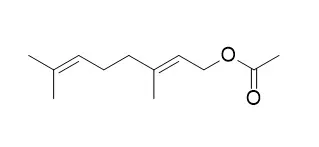| In vitro: |
| Microbial Cell Factories, 2018, 17(1):85. | | Engineering Saccharomyces cerevisiae for the production of the valuable monoterpene ester geranyl acetate.[Pubmed: 29866124] | Geranylacetate is widely used in the fragrance and cosmetic industries, and thus has great economic value. However, plants naturally produce a mixture of hundreds of esters, and geranyl acetate is usually only present in trace amounts, which makes its economical extraction from plant sources practically impossible. As an ideal host for heterologous production of fragrance compound, the Saccharomyces cerevisiae has never been engineered to produce the esters, such as geranyl acetate.
METHODS AND RESULTS:
In this study, a heterologous geranyl acetate synthesis pathway was constructed in S. cerevisiae for the first time, and a titer of 0.63 mg/L geranyl acetate was achieved. By expressing an Erg20 mutant to divert carbon flux from FPP to GPP, the geranyl acetate production increased to 2.64 mg/L. However, the expression of heterologous GPP had limited effect. The highest production of 13.27 mg/L geranyl acetate was achieved by additional integration and expression of tHMG1, IDI1 and MAF1. Furthermore, through optimizing fermentation conditions, the geranyl acetate titer increased to 22.49 mg/L.
CONCLUSIONS:
We constructed a monoterpene ester producing cell factory in S. cerevisiae for the first time, and demonstrated the great potential of this system for the heterologous production of a large group of economically important fragrance compounds. |
|






 Cell. 2018 Jan 11;172(1-2):249-261.e12. doi: 10.1016/j.cell.2017.12.019.IF=36.216(2019)
Cell. 2018 Jan 11;172(1-2):249-261.e12. doi: 10.1016/j.cell.2017.12.019.IF=36.216(2019) Cell Metab. 2020 Mar 3;31(3):534-548.e5. doi: 10.1016/j.cmet.2020.01.002.IF=22.415(2019)
Cell Metab. 2020 Mar 3;31(3):534-548.e5. doi: 10.1016/j.cmet.2020.01.002.IF=22.415(2019) Mol Cell. 2017 Nov 16;68(4):673-685.e6. doi: 10.1016/j.molcel.2017.10.022.IF=14.548(2019)
Mol Cell. 2017 Nov 16;68(4):673-685.e6. doi: 10.1016/j.molcel.2017.10.022.IF=14.548(2019)